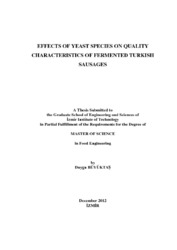Please use this identifier to cite or link to this item:
https://hdl.handle.net/11147/3537Full metadata record
| DC Field | Value | Language |
|---|---|---|
| dc.contributor.advisor | Korel, Figen | - |
| dc.contributor.author | Büyüktaş, Duygu | - |
| dc.date.accessioned | 2014-07-22T13:51:45Z | - |
| dc.date.available | 2014-07-22T13:51:45Z | - |
| dc.date.issued | 2012 | - |
| dc.identifier.uri | http://hdl.handle.net/11147/3537 | - |
| dc.description | Thesis (Master)--Izmir Institute of Technology, Food Engineering, Izmir, 2012 | en_US |
| dc.description | Includes bibliographical references (leaves: 80-86) | en_US |
| dc.description | Text in English; Abstract: Turkish and English | en_US |
| dc.description | xii, 86 leaves | en_US |
| dc.description | Full text release delayed at author's request until 2015.01.09 | en_US |
| dc.description.abstract | In this study, the effects of yeast species in combination with starter cultures on the chemical, physical, microbiological, organoleptic and aroma characteristics of fermented Turkish sausages (sucuk) during processing and storage were investigated. Debaryomyces hansenii and Yarrowia lipolytica were used as yeast species. During processing a decrease in moisture content and water activity and an increase in protein and fat contents were determined. The pH values of sausage samples decreased while titratable acidity values increased during ripening. Thiobarbituric acid values of samples having Y.lipolytica in combination with starter cultures increased during ripening and decreased during storage. Non-protein nitrogen contents of sausage samples showed an increase during processing while protein solubility of all samples decreased during ripening and storage. Moreover, addition of yeast species did not show any difference in protein solubility. According to sodium dodecyl sulfate-polyacrylamide gel electrophoresis profiles, sarcoplasmic and myofibrillar proteins were not affected by the addition of yeast species. Addition of yeast species did not have any important effect on the color of sausage samples during fermentation and ripening. Total aerobic mesophilic bacteria and lactic acid bacteria counts increased, but Enterobacteriaceae and yeast counts decreased in all samples. Moreover, micrococci/staphylococci counts decreased in all samples. It was determined that an important part of the volatile fraction in all sausage samples is composed of terpenes. Samples having Y.lipolytica in combination with starter cultures had the lowest lipid oxidation derived volatile compounds. According to the sensory analysis, samples having yeast species had the highest overall acceptability scores. | en_US |
| dc.language.iso | en | en_US |
| dc.publisher | 01. Izmir Institute of Technology | en_US |
| dc.rights | info:eu-repo/semantics/openAccess | en_US |
| dc.subject.lcsh | Sausages | en |
| dc.subject.lcsh | Meat--Microbiology | en |
| dc.subject.lcsh | Yeast fungi--Biotechnology | en |
| dc.title | Effects of Yeast Species on Quality Characteristics of Fermented Turkish Sausages | en_US |
| dc.type | Master Thesis | en_US |
| dc.institutionauthor | Büyüktaş, Duygu | - |
| dc.department | Thesis (Master)--İzmir Institute of Technology, Food Engineering | en_US |
| dc.relation.publicationcategory | Tez | en_US |
| local.message.claim | 2025-03-04T13:34:12.078+0300|||rp02564|||submit_approve|||dc_contributor_author|||None | * |
| item.languageiso639-1 | en | - |
| item.grantfulltext | open | - |
| item.fulltext | With Fulltext | - |
| item.openairecristype | http://purl.org/coar/resource_type/c_18cf | - |
| item.openairetype | Master Thesis | - |
| item.cerifentitytype | Publications | - |
| crisitem.author.dept | 03.08. Department of Food Engineering | - |
| Appears in Collections: | Master Degree / Yüksek Lisans Tezleri | |
Files in This Item:
| File | Description | Size | Format | |
|---|---|---|---|---|
| 453949.pdf | MasterThesis | 1.66 MB | Adobe PDF |  View/Open |
CORE Recommender
Page view(s)
326
checked on Jun 10, 2025
Download(s)
190
checked on Jun 10, 2025
Google ScholarTM
Check
Items in GCRIS Repository are protected by copyright, with all rights reserved, unless otherwise indicated.